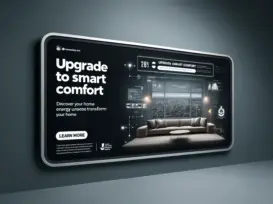Grus Home Energy - Home Thermostat
Maximizing Home Comfort with a Smart Thermostat
As the technology in our homes continues to advance, smart thermostats have become a popular choice for homeowners looking to optimize their comfort levels and energy efficiency. A home thermostat is a crucial component of any heating and cooling system, as it controls the temperature inside your home and regulates when your HVAC system turns on and off. Smart thermostats take this functionality to the next level by allowing you to remotely control your home’s temperature through a smartphone app, as well as providing features such as scheduling, energy usage tracking, and adaptive learning.
One of the key benefits of a smart thermostat is the ability to create personalized schedules based on your daily routine. By programming your thermostat to lower the temperature when you’re away from home or asleep, you can save on energy costs without sacrificing comfort. Many smart thermostats also offer adaptive learning capabilities, where the device learns your habits and adjusts the temperature settings automatically to maximize efficiency.
Another advantage of smart thermostats is their energy usage tracking feature, which allows you to monitor how much energy your HVAC system is using and adjust your settings accordingly. By understanding how your heating and cooling habits impact your energy consumption, you can make informed decisions to reduce your carbon footprint and save money on your utility bills.
In addition to the convenience and energy-saving benefits, smart thermostats also offer compatibility with other smart home devices, such as voice assistants like Amazon Alexa and Google Assistant. This integration allows you to control your thermostat with simple voice commands or create custom automation routines that sync with your other smart devices. For example, you could set up a routine that turns off your lights and adjusts your thermostat when you leave the house, ensuring that you’re always maximizing your energy efficiency.
When choosing a smart thermostat for your home, there are a few key features to consider. Look for a thermostat that is compatible with your existing HVAC system and has a user-friendly interface that suits your preferences. Consider whether you want a thermostat that offers remote access, scheduling capabilities, or energy tracking, and select a model that aligns with your priorities.
Overall, a smart thermostat is a valuable investment for any homeowner looking to enhance their comfort levels, improve energy efficiency, and integrate their heating and cooling system with other smart home devices. By taking advantage of the advanced features and customization options that smart thermostats offer, you can create a more comfortable and efficient living environment for you and your family.
Blog, Energy & Electricity Basics , April 24, 2024 , Central Air Conditioning Thermostat, Electric Heating Thermostat, Fresh Air Thermostat, Heat Pump Thermostat, Home Thermostat, Smart Thermostats, Solar Water Heater Thermostat, Thermostat, Thermostat Type, Thermostats Types, Underfloor Heating Thermostat, Water Heater Thermostat
©2025 All Rights Reserved. Grus IoT Co.,Ltd.
